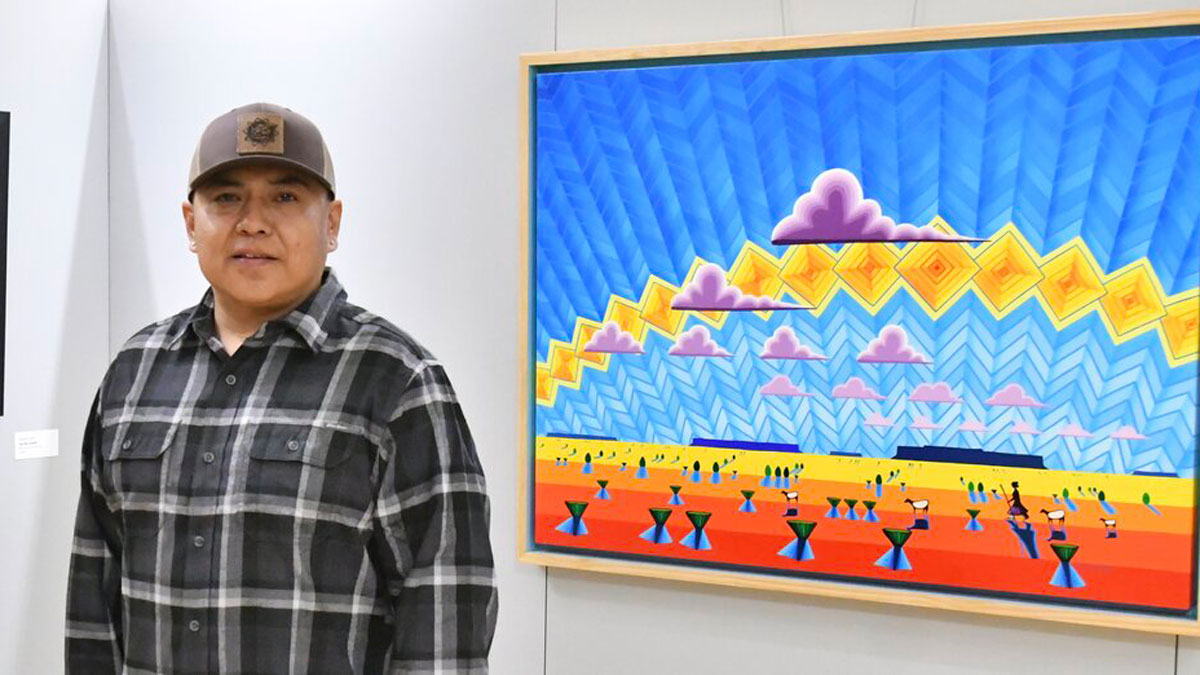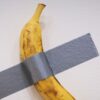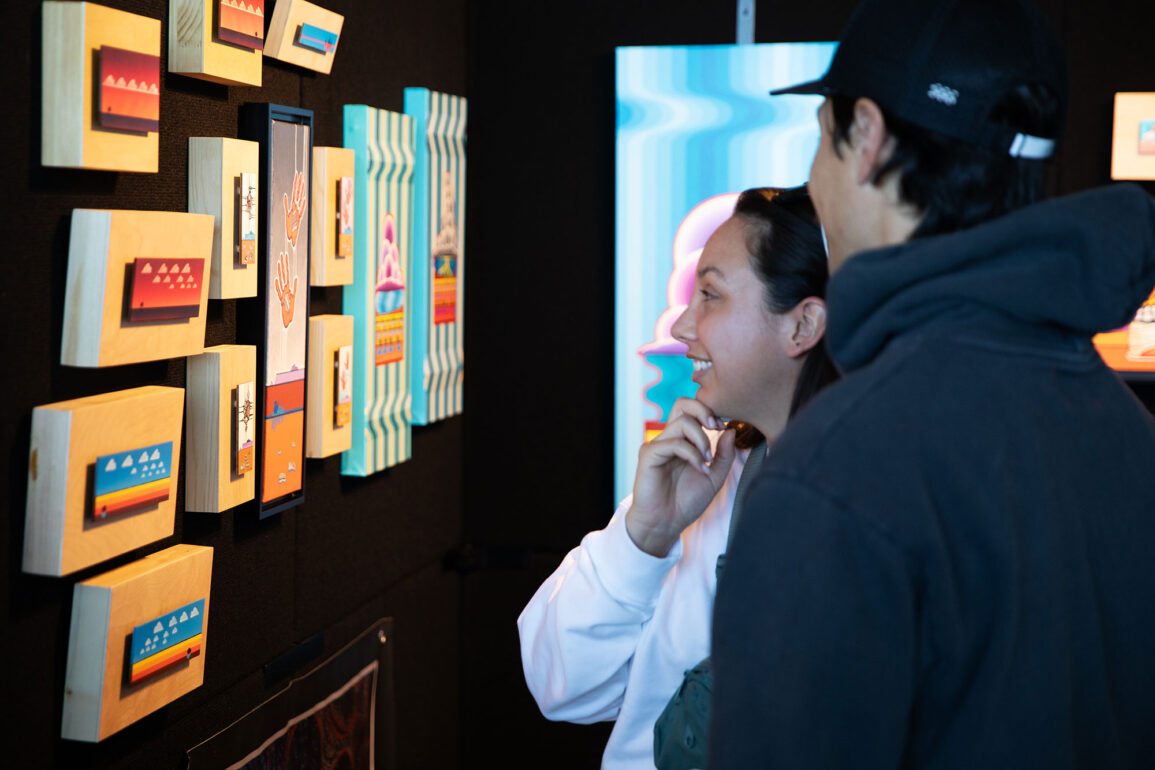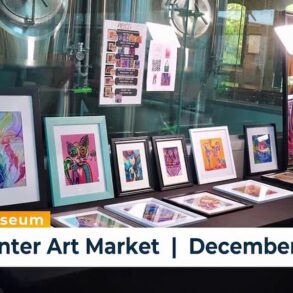To some, the vibrancy of Gilmore Scott’s paintings is otherworldly. To Scott, his use of vivid hues and geometric patterns is deeply rooted in this world, growing up on the Diné (Navajo) Nation surrounded by Indigenous art and hearing his people’s traditional stories.
“The colors in my palette are in the desert. If you take the time to look, you’ll find these strong blues and deep reds and oranges,” Scott said. “My mom was a rug weaver, and I was inspired by the geometric elements in her work. As I slowly learned the stories behind the designs—it’s such a beautiful form of storytelling.”

PHOTO CREDIT: Mark Johnston/NHMU
Admirers view Gilmore Scott’s paintings at an Indigenous art market.
You can see Scott’s paintings—and meet the artist—at the 2024 Indigenous Art Market at the Natural History Museum of Utah on Saturday, Oct. 12 and Sunday, Oct. 13, from 10 a.m. to 5 p.m. The annual event draws some of the country’s most talented Native American artists to Salt Lake City where they show and sell fine jewelry, pottery, sculptures, carvings, kachinas, paintings, weavings, beadwork, sand paintings and more. The weekend is a celebration of Indigenous art that also includes dance and music performances and an ethnography collections showcase.
Scott, who has sold his paintings at NHMU’s market since its first year in 2013, says the event is not to be missed.
“The museum’s market is the only one that I know of in Utah that strives to keep that higher quality of workmanship and craftsmanship, and it really shows,” Scott said. “It’s a great opportunity for people who want to view Indigenous art from Indigenous artists, not so much Native-inspired artwork which we’ve fought against for a long time,” Scott said.
The market is included with museum admission, which is always free for University of Utah staff, students and faculty with a UID and museum members. Guests enrolled with a state or federally or state recognized tribe in the United States are eligible for free admission to NHMU and the market with your tribal ID or enrollment card. All art is purchased directly from the artists, who keep 100 percent of all sale proceeds.
Monsoons Dazzle Over the Bears Ears

PHOTO CREDIT: Gilmore Scott
Monsoons Dazzle Over the Bears Ears, Gilmore Scott’s painting at the Utah Museum of Fine Arts.
“The Indigenous Art Market at NHMU offers a wonderful opportunity to experience and collect genuine Native artwork while engaging with the artists in person,” said Suzanne Ruhlman, museum store manager and the visionary behind NHMU’s Indigenous Art Market. “It’s so wonderful to meet the artist and hear the story of the piece you fall in love with.”
Like Scott’s signature piece, “Monsoons Dazzle Over the Bears Ears,” hanging in the Utah Museum of Fine Arts on the University of Utah campus. The painting has elements from rug design, traditional stories and the thunderstorms that sweep across the mesas near his home in the Bears Ears National Monument, an area encompassing nearly 2 million acres in the southwestern corner of Utah. The Diné (Navajo) Nation, Hopi, Ute Mountain Ute, Ute Indian Tribe of the Uintah and Ouray Reservation, and the Pueblo Zuni have ancestral ties to the region. The Bears Ears refer to a geological formation that resembles a bear head, which is often featured in Scott’s work. While most images show the monument from the west looking east, Scott grew up with the perspective from the east looking west, which more clearly shows the two buttes that make the ears and the mesa that makes the snout. Along with the deeply personal perspective of the landscape and the geometry from rug weavers, it’s also rooted in the Diné stories about thunderstorms.
“The Diné consider a thunderstorm with dark clouds, lighting and torrential rain to be male. Female rain is a gentle, slow-moving rain that can be accompanied by low clouds and mist,” explains the placard displayed next to Scott’s painting at the UMFA.
Scott always loved to draw. As a child growing up in Blanding, Utah, he participated in summer school art programs and practices with various media. In high school, Scott’s art class was structured to provide a strong foundation in the basics of art. The teacher was the first to plant the seed of art as a potential career.
“My art teacher was a big encouragement. During the summers I’d take his art class while doing odd jobs outside in the heat,” Scott remembered. “He would always jokingly say, ‘You could make money painting inside with air conditioning instead of working in the heat!”

PHOTO CREDIT: Courtesy of Gilmore Scott
Gilmore Scott, renown Diné artist.
Scott continued his education at the Utah State Extension campus in Price, Utah, taking art classes while working at the school’s little gallery, eventually pursuing a fine arts degree at Utah State University. During the summers he worked as a wildland firefighter and fell in love with the comradery and excitement the career offered. Just shy of graduating he left to fight fires full time for a decade before leaving the career to focus on art full-time. It took him some years to find his style—while developing his signature colors and patterns, he credits learning and studying traditional Diné stories as the piece that brought his artistic journey together.
“A big influence is my culture, coming from the Diné people. I transitioned from remembering a few stories that my mom told me to finally trying to transition those stories into paintings,” Scott said. “It sounds easy, but it took a long journey.”
Meet Scott and see his work at the Indigenous Art Market at NHMU on October 12 and 13. Get more information and reserve tickets at nhmu.utah.edu/market.
MEDIA & PR CONTACTS








